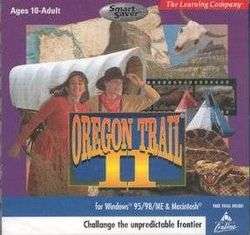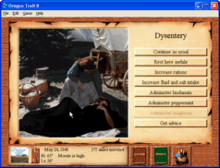Oregon Trail II
| Oregon Trail II | |
|---|---|
 | |
| Developer(s) | MECC |
| Publisher(s) | SoftKey Multimedia |
| Platform(s) | Apple Macintosh, MS-DOS, Microsoft Windows |
| Release date(s) | February 13, 1995 |
| Genre(s) | Educational |
| Mode(s) | Single player |
Oregon Trail II is an educational video game released by MECC in 1995. It was published by SoftKey Multimedia. It is a revised version of the original Oregon Trail computer game. It was redesigned with the help of American Studies PhD Wayne Studer. In contrast to the original version of the game, Oregon Trail II made an effort to include greater roles for women and racial minorities.
In addition to the regular edition, MECC released a 25th Anniversary Limited Edition Oregon Trail II Computer Game. The CD-ROM came with an official strategy guide and certificate of authenticity, all packaged in a commemorative wooden storage box.
Gameplay

Oregon Trail II includes far more detail than the original. For instance, rafting down the Columbia River is a much greater challenge than it was in the original game. Whenever an event (e.g. an accident or illness) happens, the game halts and the player must decide what to do in response, so it is much more interactive than the previous version. Players are also able to talk with other settlers along the way and ask their advice when needed.
This version also allows the player to choose between 20 years of travel (rather than 1 in the original) from 1840 to 1860. Travel is much easier in later years, as there are more towns and trading posts along the way to resupply your party. The online guidebook resource alters its displayed help based upon the year of travel, but not with the target and trailhead ends chosen—hence to read the book, one needs wade past pages of useless information applicable to sub-scenarios (such as alternate routes over a local regional stretch) one hasn't chosen. However at any point in the game, if the player dies, the game is over.
At the beginning ("New Game"), players may start a new game where they choose their name, occupation, level, date of travel, their starting point and destination, and type of wagon. Also, they may select how many others are with them in their wagon, along with their names and ages.
Outfitting the supplies and choosing the parties equipment of their journey becomes a possible point of player control leading to increased scoring chances. One has the option of taking a computer generated "package deal", ostensibly offered by the trailhead town's merchants and sized for five or six months of consumables. Or the player can shop the town and choose his own strategy, quantities, tools and so forth—or take the package then shop or trade in addition to that. One problem with the package is finding someone to trade you for something you want to get rid of or have less of, for something you'd rather take, get, or have. Conversely, some assets are only available by the package (e.g. Chains, anvils, plows) or by trading—though many of those can be purchased from merchants or blacksmiths farther down the trails. If a player decides to buy supplies without the package, the player may buy chains or anvils from Westport, Fort Kearny or Fort Laramie. All forts or towns with a blacksmith's shop will sell chains, nails (measured in pounds), and anvils.
In Oregon Trail II, the player can choose from a number of different occupations, many with different skills that can assist you in your journey across the west.
After selecting an occupation, the player can select various skills by clicking the word "Skills". The player chooses skills with a 120-point limit. Automatic skills are free. The more important the skill is, the more it costs. Each skill can make something good more likely to happen and something bad to less likely to happen.
While some occupations have more money than others, the low income occupations get a greater final bonus, which proves crucial in getting a decent score in the end of the game. However, if the player settles at a destination other than the one they had selected at the start of the game, they will not receive a bonus, regardless of their chosen occupation.
The game offers players an immense selection of supplies available for purchase. During the beginning of the game, package deals are available up to six months of provisions. However, many perils in the game will cause many provisions to be lost or used for trade.
Another factor that plays into the game is the weight of your wagon. The more supplies, the heavier the wagon. After you reach your wagon's weight limit, you will not be able to continue on the trail and may have to dump goods.
Remake
A remake of this game, entitled Oregon Trail 5th Edition, adds various new features to the game. The plant gathering feature was carried over from editions 3 and 4. The "Wild Fruits and Vegetables" event from Oregon Trail II is removed. This feature involves identifying which plants are edible and which are poisonous. (Incidentally, the option to "go look for edible plants" whenever someone is diagnosed with scurvy was kept.) The player can also go fishing. Updated graphics have been provided for river crossings. There are also added cinematics which follow the fictional journey of three children: Parker, Cassie, and Jimmy, who leave Independence accompanied by an African-American trailblazer named Captain Jed Freedman to search for the children's father in Oregon. Various points of the children's story are triggered when the player reaches a certain destination on the trail, which ranges from dangerous experiences (Jimmy contracts snakebite) to campfire scenes in which Captain Jed would tell a story that reflects other historically accurate incidents (e.g. the Donner Party, the California Gold Rush, and the Santa Fe Trail). The conversation pictures are no longer animated. The soundtrack of Oregon Trail II has also been removed, replaced with a single repeating audio loop.
Notes
A medicine named "Duffy's Elixir" appears in the game, and is promoted by a suspicious salesman. The name of this medicine is likely derived from actual medicine Daffy's Elixir.
Looking for edible plants whenever someone is diagnosed with scurvy has a very low chance of success. In the remake, it is pointless as the player can go plant hunting at any time during the game.
Much of the "advice" given does not relate to anything the user does within the game. An example is to "not pack your wagon until you bring in all your supplies". This is useless advice, as the wagon is packed automatically.
In some towns and forts, a physician informs the player than he has been informed that the player's party has been seeking a doctor. This happens even when all party members are in good health.
When a search party for a missing person is unsuccessful, the health status menu classifies their health as "missing".
There seems to be a time limit in the game. The player can rest outside the starting town with plenty of food for about 2 years until the party leader suddenly dies, ending the game. However, a glitch was discovered that allows the player to continue their journey without a single member of their party dying. YouTube user Tatsuhiko exploited this glitch in a video he made called "Let's Break Oregon Trail 2!" The party members will all be in critical condition, but none of them will die. This includes the party leader. It may take a few attempts to do it correctly.[1]
You are sometimes told to write to your family back home. This is not possible in the actual game.
Furniture serves no purpose other than additional points at the end.
See also
References
- ↑ "Let's Break Oregon Trail 2!". www.youtube.com. 11 August 2014. Retrieved 5 September 2016.